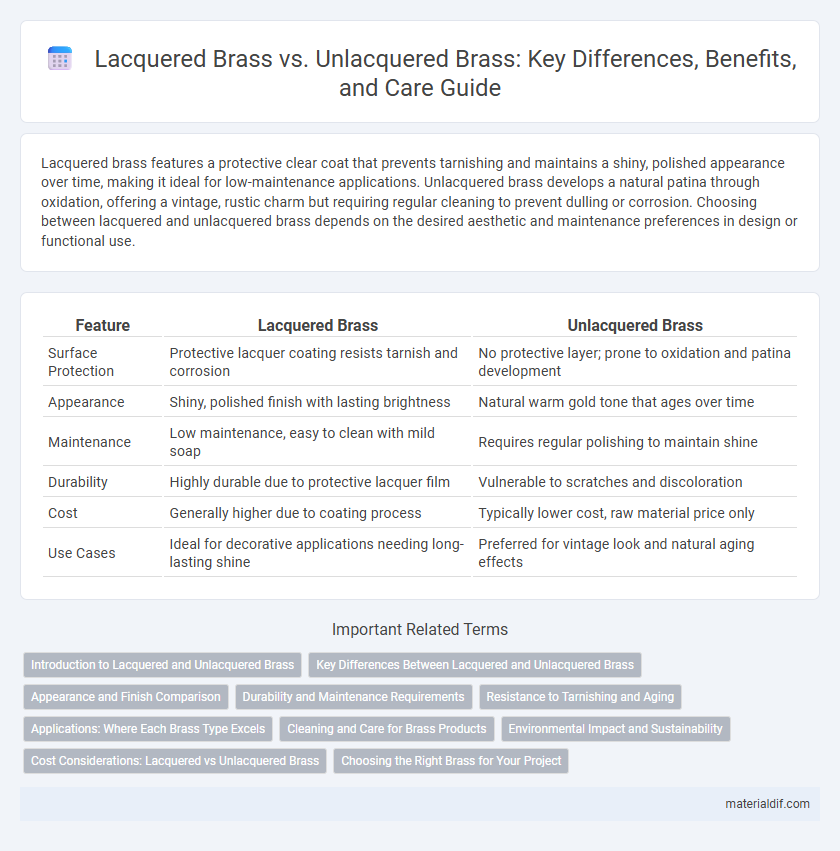Lacquered brass features a protective clear coat that prevents tarnishing and maintains a shiny, polished appearance over time, making it ideal for low-maintenance applications. Unlacquered brass develops a natural patina through oxidation, offering a vintage, rustic charm but requiring regular cleaning to prevent dulling or corrosion. Choosing between lacquered and unlacquered brass depends on the desired aesthetic and maintenance preferences in design or functional use.
Table of Comparison
| Feature | Lacquered Brass | Unlacquered Brass |
|---|---|---|
| Surface Protection | Protective lacquer coating resists tarnish and corrosion | No protective layer; prone to oxidation and patina development |
| Appearance | Shiny, polished finish with lasting brightness | Natural warm gold tone that ages over time |
| Maintenance | Low maintenance, easy to clean with mild soap | Requires regular polishing to maintain shine |
| Durability | Highly durable due to protective lacquer film | Vulnerable to scratches and discoloration |
| Cost | Generally higher due to coating process | Typically lower cost, raw material price only |
| Use Cases | Ideal for decorative applications needing long-lasting shine | Preferred for vintage look and natural aging effects |
Introduction to Lacquered and Unlacquered Brass
Lacquered brass features a protective coating that prevents tarnishing and corrosion while preserving its bright, polished appearance. Unlacquered brass naturally oxidizes over time, developing a patina that adds character but requires regular maintenance to avoid discoloration. Choosing between lacquered and unlacquered brass depends on balancing long-term durability with the desired aesthetic finish.
Key Differences Between Lacquered and Unlacquered Brass
Lacquered brass features a protective clear coating that prevents tarnishing and maintains its shiny, polished appearance over time, making it easier to clean and ideal for low-maintenance applications. Unlacquered brass develops a natural patina through oxidation, which enhances its aesthetic with an aged, rustic look but requires regular polishing to prevent corrosion. The primary distinction lies in lacquered brass offering durability and consistent shine, while unlacquered brass provides evolving character and requires more upkeep.
Appearance and Finish Comparison
Lacquered brass features a glossy finish that preserves its bright, golden hue while protecting against tarnish and oxidation, maintaining a polished look over time. Unlacquered brass develops a natural patina, offering a vintage or antique appearance that evolves with exposure to air and moisture. The choice between lacquered and unlacquered brass depends on desired aesthetic longevity versus the preference for an organic aging process that adds character to the metal.
Durability and Maintenance Requirements
Lacquered brass offers enhanced durability by providing a protective coating that prevents tarnishing and corrosion, reducing the need for frequent polishing and maintenance. Unlacquered brass develops a natural patina over time, which can add character but requires regular cleaning and polishing to maintain its original shine. Choosing lacquered brass is ideal for low-maintenance environments, while unlacquered brass suits applications where a vintage or evolving appearance is desired despite increased upkeep.
Resistance to Tarnishing and Aging
Lacquered brass offers superior resistance to tarnishing and aging due to its protective clear coating that prevents oxidation and exposure to moisture. Unlacquered brass naturally oxidizes over time, developing a patina that can be desirable for aesthetic reasons but requires regular maintenance to prevent corrosion. Choosing between lacquered and unlacquered brass depends on the desired balance between durability and the evolving appearance of the material.
Applications: Where Each Brass Type Excels
Lacquered brass excels in applications requiring corrosion resistance and low maintenance, such as decorative fixtures, musical instruments, and plumbing components exposed to moisture. Unlacquered brass is favored for items needing natural patina development or frequent polishing, making it ideal for antique restoration, high-end hardware, and artistic sculptures. Choosing between lacquered and unlacquered brass depends on environmental exposure and desired aesthetic longevity in projects.
Cleaning and Care for Brass Products
Lacquered brass requires gentle cleaning with a soft cloth and mild soap to preserve its protective coating, preventing tarnish and corrosion. Unlacquered brass benefits from regular polishing with a brass-specific cleaner or a mixture of lemon juice and baking soda to maintain its natural shine and prevent oxidation. Avoid abrasive materials on both types to prevent surface damage and ensure long-lasting brass products.
Environmental Impact and Sustainability
Lacquered brass features a protective coating that reduces the need for frequent polishing and cleaning chemicals, lowering its environmental footprint by minimizing chemical runoff. Unlacquered brass, while requiring more maintenance, is fully recyclable and decomposes naturally without releasing harmful substances, offering greater sustainability in end-of-life disposal. Choosing between lacquered and unlacquered brass depends on balancing initial chemical use with long-term recyclability and environmental impact.
Cost Considerations: Lacquered vs Unlacquered Brass
Lacquered brass typically incurs higher costs due to the additional protective coating process, which enhances durability and reduces maintenance expenses over time. Unlacquered brass has a lower upfront cost but may require frequent polishing and care to prevent tarnishing, increasing long-term maintenance costs. Budget considerations should balance initial investment against ongoing upkeep when choosing between lacquered and unlacquered brass.
Choosing the Right Brass for Your Project
Lacquered brass offers enhanced corrosion resistance and a glossy finish, making it ideal for decorative projects requiring low maintenance. Unlacquered brass develops a natural patina over time, which adds character and antique appeal, suitable for vintage or rustic designs. Selecting between lacquered and unlacquered brass depends on whether durability and shine or natural aging and authenticity are priorities for your project.
Lacquered Brass vs Unlacquered Brass Infographic

 materialdif.com
materialdif.com